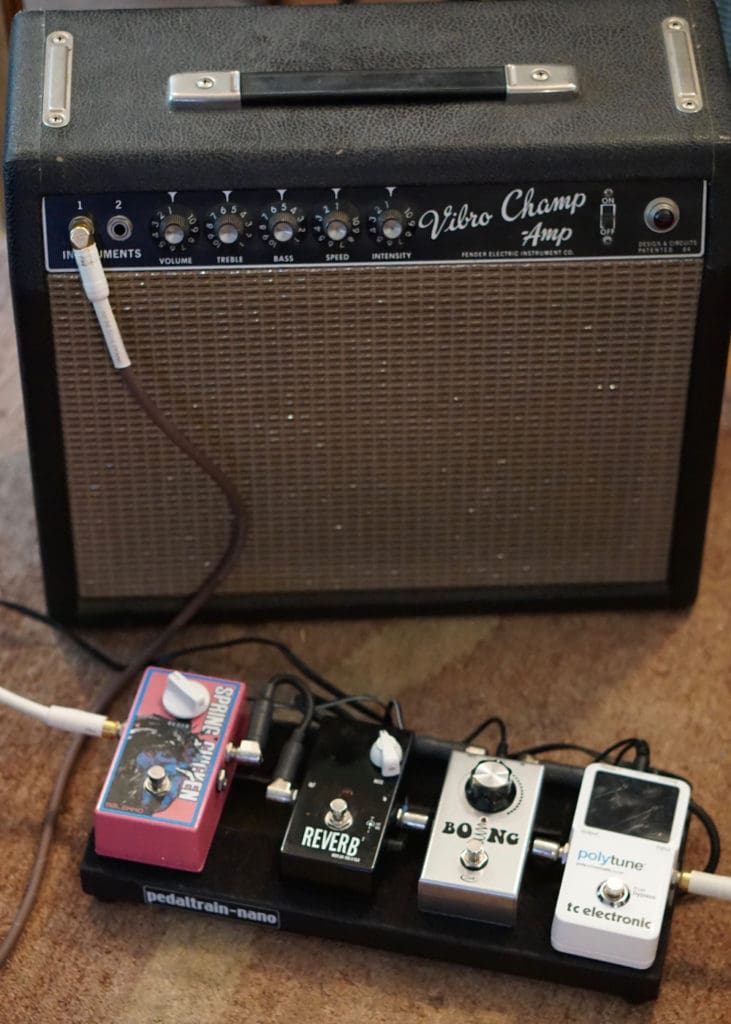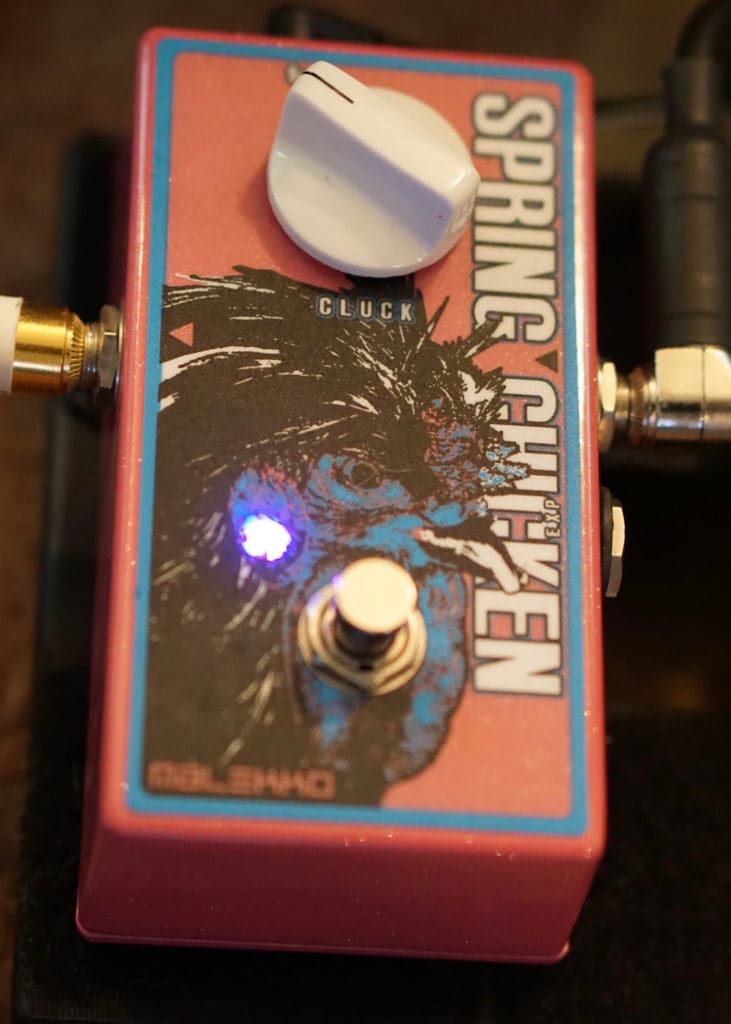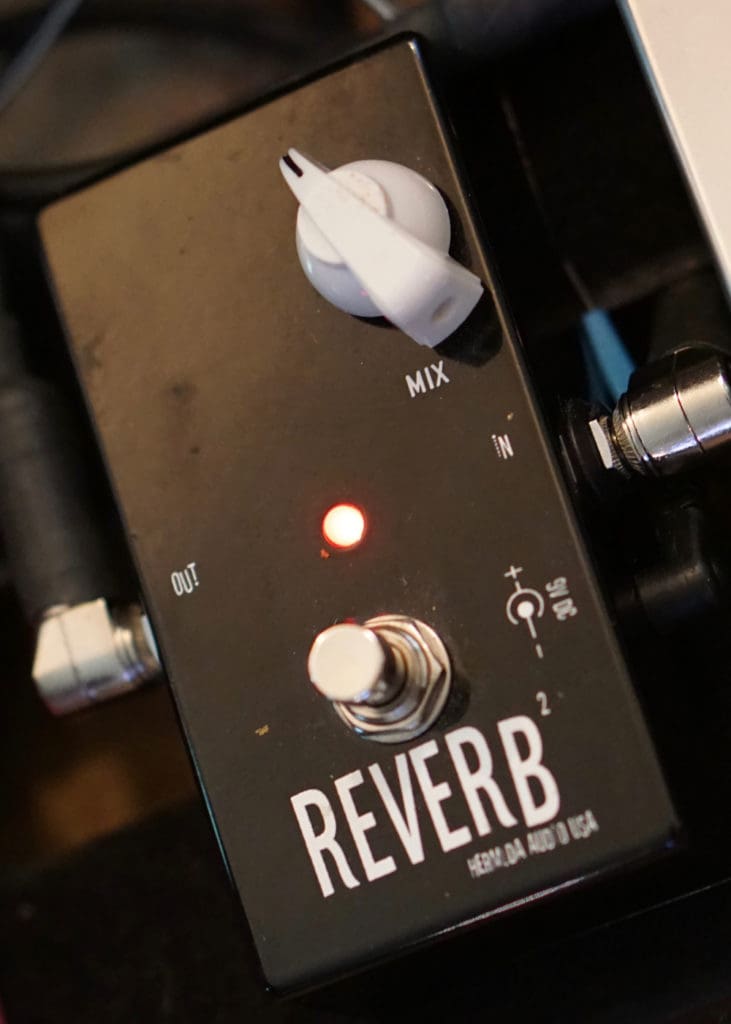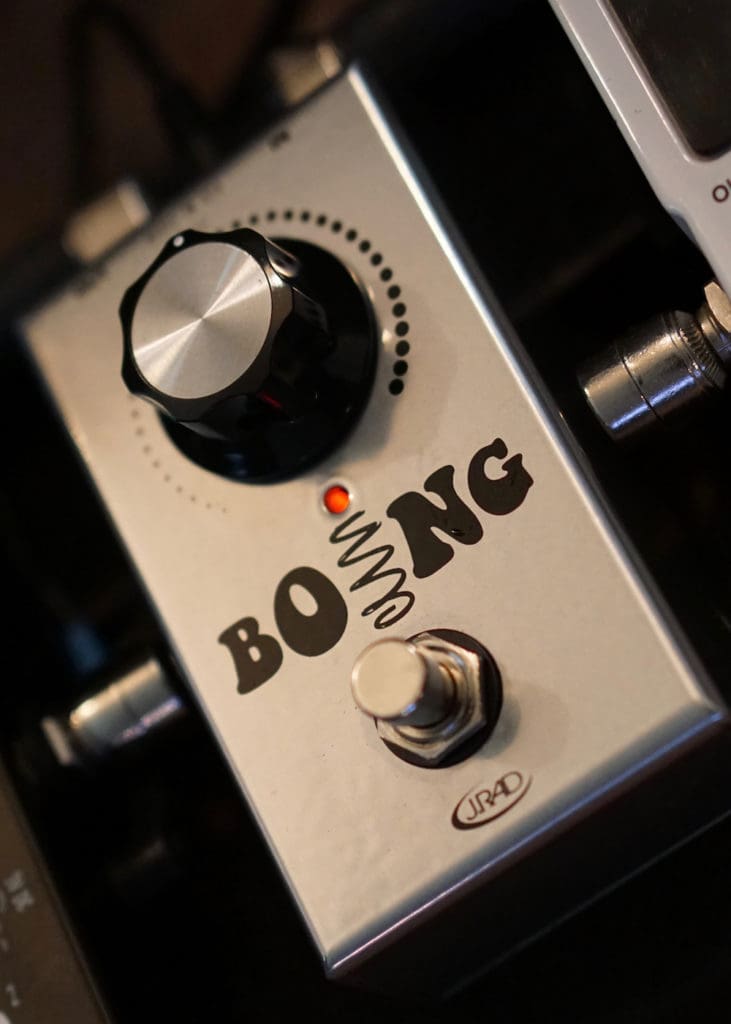Ah, the reverb conundrum… For most guitar players, in its iconic state, reverb is one knob – labeled “Reverb” – third from the right on the control panel of their favorite Fender amp. Whenever you find it on any tube amp, that’s all it’s going to be: one knob controlling the mix of wet/dry signal affected by a spring-loaded reverb tank. From there, reverb gets complicated in various ways. Aficionados with no concerns for loads or space can turn to standalone reverb (or reverb-tremolo) units, powered by their own complements of tubes, sporting varying numbers of knobs, starting with “Mix” and “Dwell,” perhaps incorporating “Tone” and “Volume” (sometimes both for input and output) – full disclosure: I own such a unit, made by Seattle-area amp-builder Jack Anderson, and it is the ne plus ultra of reverb… but it does not fit on my pedalboard. Those who turn to pedals for reverb see the same range of functionality and can throw in additional switches to boot, as digital options allow for spring, hall, plate and other types of ‘verb. Oddly, we seem to be living in a time when there are precious few pedals doing that definitive reverb thing, with one knob, giving us more or less reverb as we twist it one way or the other.

That said, there are a few, and if you peruse the used market there are a few more. For better or worse, two of the three pedals in this installment of Hands On: One-Knob Wonders have been “upgraded” to two-knob pedals in their latest iterations, so we’re going to ask for a bit of indulgence as we stick hard to our concept and indulge in a bit of selective versioning. So, without further ado, let’s take a look at the classic Malekko Spring Chicken, the Lovepedal “Hermida” Reverb 2 and the J. Rockett Boing pedals.
[For our purposes, we’re going to do a straight-up evaluation of the pedals, without comparing them to “real” reverb. We lined ‘em up and plugged ‘em into a ’64 Fender Vibro Champ au naturale, sans overdrives or boosts or compression or whatever. We pulled out a Yanuziello, the cleanest, most tonally pure guitar we could find (but we didn’t look too hard) – it isn’t at all Rockabilly Beast or Surf Machine, but it gave us a perfect neutral test bed for this exercise.]
Malekko Spring Chicken (2-knob Limited Edition: $179; used 1-knob original version: ~$100)

Once I moved on from my very first guitar amp, a Fender Champ, every amplifier I owned had built-in reverb until I got an odd little custom-built 18-watt head, a variant on the Marshall design, with tremolo but no reverb (the chassis was too small for a tank). I missed having reverb pretty much right away and started looking for a simple solution, something more than the Electro-Harmonix Holy Grail (which misses qualifying as a “one-knob wonder” because of its “spring-hall-flerb” switch) but simpler (and cheaper) than a standalone unit. Enter the Spring Chicken. The Spring Chicken is, um… an odd duck, as it were. The graphics kinda creep me out, frankly. The knob controlling the mix of the wet/dry signal is labeled “Cluck,” because, well, there is a quality to the spring emulation that does suggest the gurgle of a contented chicken, I guess. The reverb is big, tonally neutral, and you can hear the echoes in the emulation easily enough. One particularly intriguing feature is support for an expression pedal, for those so inclined. The spring thing is clearly the focus here, though, and you’re going to like it or not based on how you feel about their emulation.
The new version of this pedal adds a side-mounted “Dwell” knob, to control the size of the reverb, and is no longer shocking pink. The mini-pedal version (initially called “Chicklet,” now called “Spring,” with “Mix” and “Dwell” knobs but without expression pedal support) is still pink, though, if that’s a deciding factor.
Lovepedal “Hermida” Reverb 2 (used: ~$110)

So, as it happens, that spring thing isn’t my thing. Enter the Lovepedal Reverb 2, a pedal implementation of the Hermida Audio reverb. Quick background: Alfonso Hermida is quite literally a rocket scientist (he worked for NASA/Goddard Flight Space Center for twelve years) who designs effects pedals; he teamed up with Sean Michael at Lovepedal to produce several of his pedal designs, including this reverb pedal, based on a design he integrated into an amplifier for “a well-known guitar player” (*cough* Carlos Santana *cough-cough*). The Reverb 2’s sound is notably “smaller” than the Spring Chicken and distinctly warmer (or darker, depending on your perspective), with much subtler echoes in its implementation, feeling closer to a plate reverb emulation than a spring, for the most part. The marketing buzz words Lovepedal chooses to describe it – “organic” and “rich” for example – are apt, and perhaps a curiosity: in a way, the reverb feels closer to actual reverb, like you encounter in a physical space, than a guitar amplifier’s reverb, which isn’t quite a “plate” thing, but close enough, perhaps.
The pedal itself is slick, with simple white graphics on a “none more black” die-cast aluminum case, a strong red LED and a single white “chicken head” knob (why Malekko doesn’t use one is beyond my reckoning) controlling the mix of the wet (digital) signal and the dry (analog) signal (they made a big deal about using digital and analog signal paths).
The Reverb 3 pedal (also sold out at this time) tweaked the underlying circuit a bit and added a “Dwell” knob, in spite of their (well-founded, IMHO) claim that “one knob is all you need” for the Reverb 2. With that new Dwell knob the reverb can get significantly bigger, adding (in Lovepedal’s words) “more space, texture and air.”
J. Rockett Boing ($159)

Which brings us to the Boing…
This pedal is designed to emulate the reverb of a Fender Deluxe Reverb amplifier. It’s not an especially big reverb, being particularly subtle until you get to about 11 o’clock, and the “springy” echoes fall somewhere in between the Spring Chicken and the Reverb 2. In general, its tone tends brighter, which is kinda what you expect from amp reverb, particularly Fender-flavored. In some ways, it seems almost lacking in personality, sitting in between the other two, but really, that’s probably the point: this is a no bullshit amp-style reverb pedal. The unit is built like a tank, heavy and sturdy, with a great big knob, easily manipulated with the toe of your Chuck Taylors. The LED isn’t the brightest I’ve seen, and in the lower reverb settings you might actually find yourself looking to make sure the unit’s on, but, let’s face it, if you’re somewhere that the brightness of your LED matters you’re probably not going for subtle hints of reverb, and once you’re past noon there’s no missing it.
Having all these pedals lined up I found myself curious about their basic tone, something that hadn’t really occurred to me when thinking about reverbs before. So I set all of the knobs to zero and ran through ‘em, one by one. The Spring Chicken basically did nothing – on or off, the guitar sounded the same. In contrast, Reverb 2 and the Boing both altered the tone of the guitar noticeably – the Reverb 2 making it fatter/warmer/darker and the Boing making it brighter/clearer. That right there seems like as critical factor in choosing a reverb pedal as anything, which I suppose brings us to the bottom line…
Well, when I take my little Princeton clone out for gigs, the Reverb 2 comes with us. It suits me and my rig, adding some space and dimension without screaming “reverb” at the top of its lungs. On the other hand, when I gave these pedals the “Pipeline” test the Spring Chicken kinda kicked ass, and the Boing was certainly better than a poke in the eye. Meanwhile, a friend of mine looking for something to borrow for a tour is leaning toward the Boing (he’s as yet unsure if he’ll be playing through his brother’s Deluxe Reverb or his own AC30). If you know your needs, any of these pedals will serve you well, but they are certainly distinct, something a marvel for three one-knob pedals that are nominally the same effect.

I don’t understand the big B on the Spring Chicken, but I dig it. I might feel different if my name were “Lorenzo.”
[Editor’s note: Got a favorite single-knobbed pedal? Let us know!]


